Teaching and learning through a pandemic
Julie Cooper and Yvonne Rhodes | December 18, 2020
Compassionate & innovative ways Texas State University educators and students connected in 2020 as the pandemic impacted university life
Among the many things we learned from the COVID-19 pandemic, is how Texas State University students, faculty, and staff can adapt to meet a challenge. After classes moved online in March 2020, and ultimately to a mix of in-person and virtual delivery, faculty sprang into action and got creative to continue teaching and supporting students. From simple, compassionate techniques, like the mindful breathing exercises led by Dr. Claude Bonazzo in the Department of Sociology in each of his classes, to Dr. Moira DiMauro-Jackson in the Department of World Languages leveraging technology to help students explore Italy from home, 2020 was a year unlike any other in Texas State classrooms.
Explore highlights of the countless ways our faculty and staff responded in a time of crisis.
A sense of belonging
Dr. Millie Cordaro, Department of Psychology, College of Liberal Arts
Dr. Cordaro has taught a combination of in-person, online and hybrid courses for several years. “This semester I was fully online and missed the in-person connections and discussions I have with new and former students,” she says.
“Part of my teaching philosophy is that my students feel acknowledged and valued, and I'm using technology in new ways to ensure they feel a sense of belonging despite the distance. To forge individual relationships with students I’ve scheduled one-on-one Zoom chats, created personalized recordings to answer student questions via email, and featured their adorable pets on my Twitter account.
“Last spring, when we transitioned to remote instruction, I had an in-person class of 100 students that I converted to an online format. I missed them and was concerned for their well-being. I wrote the class a letter during the second week of Spring Break, so we could process the transition together before class reconvened.” Read her heartfelt letter to students.

Zoom in on 18th-century French theatre
Dr. Carole Martin, Department of World Languages and Literatures, College of Liberal Arts
Students in this Acting French class wrote and directed a Zoom adaptation of a comedy play by 18th-century French playwright Pierre de Marivaux called La Dispute. They produced a bilingual adaptation and recorded the scenes using Zoom, which they edited into a full production of the play. Opening night was held virtually on December 9. Students Macy Birdwell and Nigel Douglas (pictured) led the publicity efforts for the show.

Virtual trip to Italy
Dr. Moira DiMauro-Jackson, Department of World Languages and Literatures, College of Liberal Arts
“I will always remember the year the world went on lockdown,” said Dr. DiMauro-Jackson. “When we were told that Education Abroad was being cancelled and I realized that these students had saved, planned and were hoping to go to Italy with the Gruppo Italia 2020, but now couldn’t. Some were seniors, so they didn’t have a second chance to go abroad with us next year. I knew I had to do something. So I decided to create this virtual education abroad program….”
She taught the university’s first education abroad course online in the summer of 2020. In addition to watching videos and completing projects related to Italy, her students held live chats with survivors of fascism and World War II. They also connected with the Italian Red Cross in Italy and Associazione Isola di Santa Croce in Florence.
We connected with a WWII survivor, Franca Auteri, who is 95 and was a young athlete when Mussolini was in power… It was an intensive summer program, one month in June, but the students’ blogs proved they loved it, and this was the best result I could ask for.” - Dr. DiMauro-Jackson
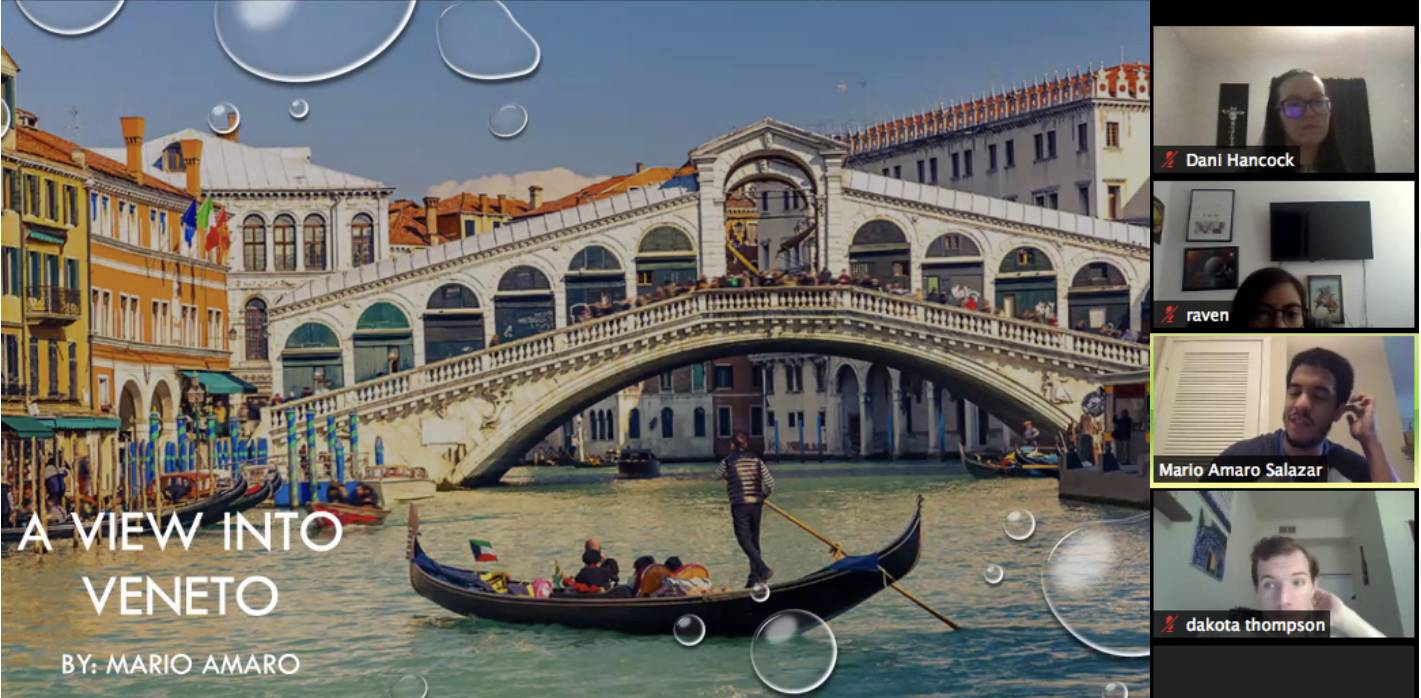
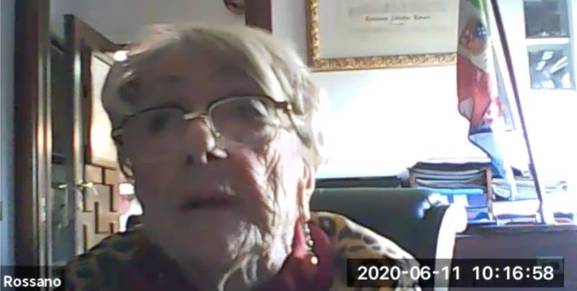
Meeting the professors from afar
Dr. Heather Galloway, Dean, Honors College
Normally the Honors College holds its Meet the Professor event in the LBJ-SC ballroom where students can browse tables and learn about the Honors courses for the upcoming semester while munching on pizza. Of course, that didn’t happen.
“We used a platform designed for an online conference to set up zoom rooms as tables for each class with information from the faculty. We also had a room where faculty and students could show up in costume to enter the costume contest.”
“We ended up with attendance from 277 students. Students were tuning in from the dorms, from across the state, from out of state and a few out of the country,” said Dean Galloway. “I suspect it was one of the largest university events where students were actually talking to each other and to faculty rather than just listening to something.”

Creative approach to teaching international politics
Dr. Ewa Siwak, Department of World Languages and Literatures, College of Liberal Arts
The final project in the German Civilization course simulates election campaigns in Germany and Austria. Students research a political party and use the discussion feature in Canvas to post info about five key political issues. They use Flipgrid to record a political video ad they have scripted, in which they play the role of a candidate. Students then submit questions for each party and the “candidates” a live townhall debate (Bürgerforum) held during class via Zoom/Breakout Rooms. As post-debate reflection, students select one party that in their opinion best represents the interest of German or Austrian citizens, and one with whose agenda they vehemently disagree, and critique those political agendas.
This two-week project encourages the students to take a closer look at countries with multi-party political systems, where different parties may rule through coalitions, or exercise power in the parliament as the opposition.
“I have designed the project to maximize peer-to-peer teaching and to encourage debate. Students have an opportunity to reflect on global issues as well as considering concerns unique to German-speaking Europe, and they accomplish all of this in advanced-level German,” Siwak says.

The COVID EFFECT, dramatic writing
Susan Busa, Department of Theatre and Dance, College of Fine Arts and Communication
Susan Busa, a dramatic writing professor, created a short piece with her web series class documenting the art of teaching during COVID-19, complete with moving interviews with faculty and staff.
THE COVID EFFECT is a five-part episodic set of personal stories describing the ways COVID affected our lives. Each episode is five minutes or less and explores a variety of stories.
In episode one, a Karate teacher juggles keeping his new baby safe and his business open, and a construction worker quits his job to help children at a local church stave off feelings of isolation. Episode two features faculty in the Department of Theatre and Dance getting creative to continue teaching dance and set-building while implementing COVID protocols. The third episode features emotional interviews with an elderly woman in a retirement center, a hospital nurse and two Texas State students sharing their personal experiences contracting COVID-19. Two Texas State students, Magen Huntley and Duncan Smith, are featured in episode four describing the challenges of producing creative work during quarantine. In the final episode, a graduating Texas State student and her high school friends create a front yard college graduation ceremony, and a bride has her church wedding online.

Sociology and the music of life
Dr. Joseph Kotarba, Department of Sociology, College of Liberal Arts
“Ordinarily, music provides a powerful, pervasive, and enjoyable social phenomenon to apply sociological theories and research methods in the classroom, but the COVID-19 pandemic has obviously forced us to rethink and redesign our research activities with students.”
The focus of Dr. Kotarba’s research is to explore the many ways music impacts everyday life. In his classes, students explored topics such as the role music plays in combatting loneliness among the elderly who are particularly confined to their homes (think Andrea Bocelli singing in Church in Milan, Italy on the Internet on Easter Sunday); and how music provides a soundtrack for the experience of the romantic crush that can occur across a lifetime.
As part of his research on music and aging, Dr. Joseph Kotarba captured the heartwarming photos below of music bringing joy to residents of assisted living facilities and nursing homes. “Students get to study social experiences that provide meaning for their lives and those of, say, their grandparents,” shared Dr. Kotarba.
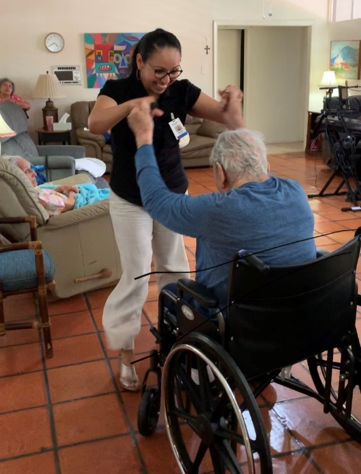
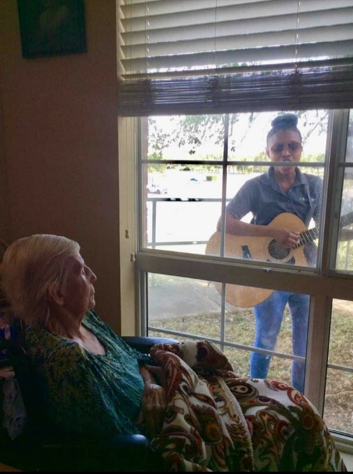
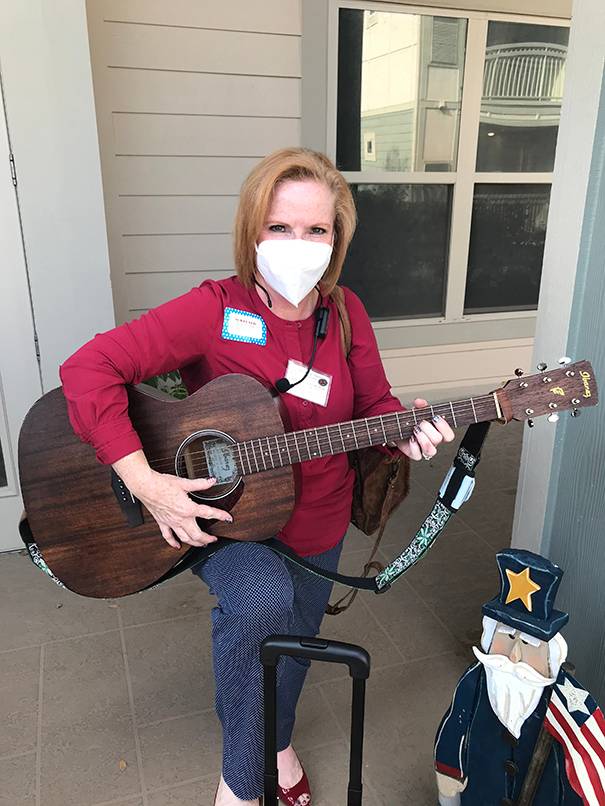
Spanish in the time of coronavirus
Dr. Susan Villaneuva Eguia Lis, Department of World Languages, College of Liberal Arts
After classes were moved online following spring break, Dr. Villaneuva Eguia Lis was inspired to talk to her students about how to build resilience by expressing your feelings through poetry.
The class read poetry written during the bubonic plague of 1556-1678, in which the writer described how people felt during quarantine and after the sickness ended. Students then wrote their own original poems in Spanish. Several of their poems were published in the Al Principio 2020 student magazine made by Sigma Delta Pi, the National Collegiate Hispanic Honor Society, Chapter Beta Epsilon at Texas State. Makaila Rhoden was one of the students whose poem was published.
“One of the advantages of teaching classes in Zoom is that we have worldwide access to live virtual events that used to be by invitation only, or that took place abroad and thus difficult to attend.” Dr. Lis took advantage of the virtual format with events that explored grief and loss and cultural expressions of the Mexican and Mexican American community during Day of the Dead, or Dia de Muertos.
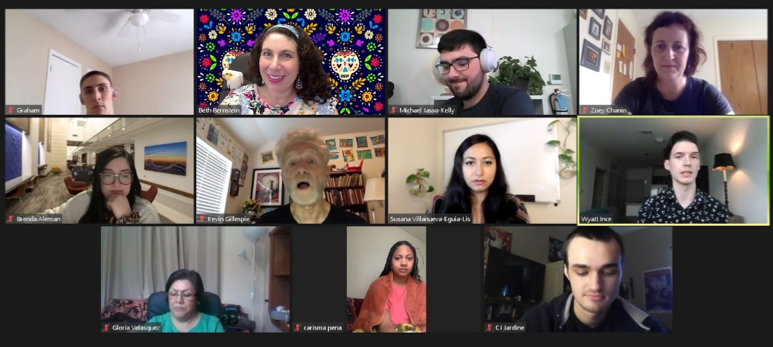
The show must go on
Michelle Nance, Department of Theatre and Dance, College of Fine Arts and Communication
To promote social distancing, dance classes transitioned to a mix of remote and in-person instruction. For in-person classes, instructors equipped dance studios with projectors, wide angle cameras, and computers to facilitate half of the students in the studio and half on Zoom during any given class day. They taped off 13 by 13 “boxes" on the floor for students to maintain physical distancing. The Department of Theatre and Dance organized an extensive virtual production season including eight virtual productions using a variety of approaches. All dance concerts were fully online in 2020, including Zoom sessions for the artists to discuss their work and participate in Q&A sessions with the audience. Prop Supervisor Erin Kehr created a weekly interview series called “Props & the Professionals,” which featured ten interviews with high-profile theatre professionals of various disciplines with a focus on props.
Performances were held in new ways - outdoors, masked-up, with social distancing. “Dancers were not allowed to touch in their choreographies this year, which is a challenge,” says Michelle Nance.

Repository of Instructional Design Ideas
Dr. Rachel Davenport, Department of Biology, College of Science and Engineering
“IDea Book is a repository of ideas for creative instruction run by our instructional designers at Texas State. They highlight a lot of cool things that faculty and staff are doing for students and teaching. Check it out for the amazing strategies our colleagues are sharing for success!” – Dr. Davenport
Instructional designers in the Office of Distance and Extended Learning at Texas State specialize in online, flipped, hybrid, and face-to-face courses. These instructional designers and course developers use innovative technology tools and teaching strategies to engage students and inspire faculty to innovate in the classroom. When they do, the university celebrates their work asks them to summarize their ideas in IDeaBook. Their collected ideas can be inspiration for assignments, activities, or discussions. Topics in IDeaBook include hyflex teaching, student success and engagement, accessibility in instruction and more. Explore IDEABook

HyFlex Inspiration
Dr. Glenna Billingsley and Dr. Julie Jackson, Department of Curriculum and Instruction, College of Education
Dr. Glenna Billingsley outlines how she took a class for special education instruction and made it work for graduate students. The key was a multimodal classroom that incorporated student choice with Zoom, Canvas (the university’s Learning Management System), in-person instruction, student discussion and group assignments.
“I have always loved in-person teaching. However, I see so many advantages to using new technologies to increase learning opportunities for students. I enjoyed the challenge of learning to teach in an alternative format and look forward to learning even more active learning strategies.” — Dr. Glenna Billingsley
“Once we establish that everyone is a scientist and that science is a way of looking at the world and asking questions, we explore how science instruction can be modified to honor diverse cultures, enhance the unique strengths of children, and celebrate science as a human endeavor.” — Dr. Julie Jackson
Dr. Julie Jackson conducted a detailed inventory on resources to take her face-to-face teaching tools and instruction up a notch for digital content to fit the remote learning model for undergraduate students. She used existing and new digital content, interactive sites, collaborative documents, and breakout rooms in Zoom to make science curriculum instruction a success in the virtual world.
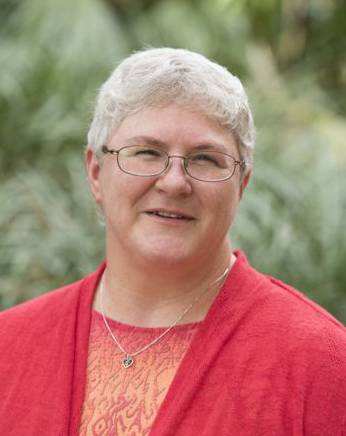

Share this article
For more information, contact University Communications:Jayme Blaschke, 512-245-2555 Sandy Pantlik, 512-245-2922 |